 Despite our catastrophic experiences with the Onkyo DAB CD unit, we’d developed a taste for DAB radio/CD combos so were right on Pure Digital’s case when they announced their new DAB/FM/CD/MP3 micro system, the DMX-50.
Despite our catastrophic experiences with the Onkyo DAB CD unit, we’d developed a taste for DAB radio/CD combos so were right on Pure Digital’s case when they announced their new DAB/FM/CD/MP3 micro system, the DMX-50.
Perhaps better known for their distinctive portable sets, Pure are a world-leading, UK-based DAB radio retailer, with a reputation for innovation.
Rolled out just in time for Christmas, the £230 ($395, €336) DMX-50 is an attractive 40W RMS micro-sized system, cunningly disguised to look like three hi-fi separates.
Finished in a pleasant grey metallic finish, the unit is dominated by a large, five-line LCD screen which provides DAB/FM radio station information, scrolling DAB digital text, CD/MP3 track listings and access to a variety of user-selectable options.
 Context-sensitive buttons either side of the display provide a simple user interface offering fast access to relevant features – it’s one of the best interfaces we’ve seen.
Context-sensitive buttons either side of the display provide a simple user interface offering fast access to relevant features – it’s one of the best interfaces we’ve seen.
Setting up the DMX-50 was an absolute breeze – no sooner had we got the thing plugged in than it was busying itself automatically locating and storing over 50 DAB stations within range. Nice.
Locating FM stations was equally swift and painless, with the large, intuitive interface making it a breeze to find, sort and order presets – kudos to Pure for simplifying a process that can sometimes turn grown men into fist-shaking balls of frustration.
Playing CDs was straightforward enough too, although the CD tray was a little too flimsy for our liking.
We especially liked the fact that it displayed both CD and MP3 track and artist information onscreen, making it easy to find tracks.
 A unique feature to Pure is the ReVu function, which lets you pause and ‘rewind’ live DAB digital radio, courtesy of a constantly updating 20 minute buffer.
A unique feature to Pure is the ReVu function, which lets you pause and ‘rewind’ live DAB digital radio, courtesy of a constantly updating 20 minute buffer.
This means that it’s possible to rewind back to the start of a show you may have missed the beginning of, or pause the radio to take a phone call.
DAB digital transmissions can be recorded (or played back) on the built in SD card slot, and a USB port lets you play back and transfer recorded files to your PC.
The USB connection can also be used to download software upgrades for the DMX-50.
Further connections come in the form of a pair of spring loaded speaker clips, two aux inputs (for plugging in an MP3 player, for example), an optical out and a Line/Sub Out for hooking the unit up to an external amplifier or connecting a sub-woofer.
 The package is rounded off by two stylish Rosewood speakers with 5¼” woofers, and 19mm Mylar-dome tweeters, a simple remote control and aerial.
The package is rounded off by two stylish Rosewood speakers with 5¼” woofers, and 19mm Mylar-dome tweeters, a simple remote control and aerial.
CONCLUSION
Quick to set up and a pleasure to use, Pure’s straightforward interface, massive LCD and impressive feature set make this a great player for music fans who don’t fancy wading through hefty manuals before they can start listening to tunes.
At this price level we weren’t looking for high-end hi-fi quality, but the DMX-50 gave a good account for itself and was a pleasure to listen to.
The bass output perhaps wouldn’t excite dub aficionados, but when cranked up, the sound was beefy enough to encourage a bit of air guitar work around the office.
Throw in CD/MP3 text, a SD slot and the unique ReVu feature and you’ve got the best all-round DAB/CD player we’ve come across so far.
Rating: Highly recommended 9/10

SPECIFICATIONS:
Amplifier: 40W RMS per channel power output (into 8 Ohms @10% THD+N, A-weighted). 10 Hz to 40 kHz (-3dB) frequency response. Bass and treble tone control.
CD player: CD-R and CD-RW playback compatible. Support for CD Text and 20 track audio CD playlist. Multiple playback modes (repeat, shuffle, etc.). MP3 playback, including support for ID3 tags and M3U playlists.
DAB: PURE ReVu™ enables pause and rewind of live DAB digital radio. Full Band III (174 – 240 MHz) reception. Fully compliant with ETS 300 401 and capable of decoding all DAB transmission modes 1-4. Fast autotune feature. 99 presets.
FM: Supports RDS and RadioText. Tune by RDS station name. 87.5-108 MHz frequency range. 99 presets.
SD card: SD card slot for recording DAB radio to SD card.
Speakers: 8 Ohms (nominal) impedance. 40W RMS power handling. Polypropolene mid-bass drivers. Two-way rear ported enclosure. Custom-tuned 2nd order crossovers.
Connectors & Cables: 3.5 mm headphone output on front panel. RF F-connector 75 Ohms for combined DAB/FM aerial connection. Two separate dual phono line-level audio inputs for auxiliary device connection. Dual phono for stereo analogue line-level output. Optical Toslink connector for digital S/PDIF output (IEC958 @ 48 kHz). USB connector for future software upgrades and SD card access. Stereo spring-clip terminals for speakers. Integral mains cable with Euro/UK adapter. Bootlace DAB/FM aerial and two 3m speaker cables supplied.
General: Fully featured remote control (batteries included). Compliant with the EMC and Low Voltage Directives (89/336/EEC and 73/23/EEC). Dimensions (mm): main unit 166 (w) x 240 (h) x 252 (d); speaker 150 (w) x 240 (h) x 255 (d). Two year warranty
PURE DMX-50
 Vodafone has started to roll out its global Mobile TV channels, serving up a feast of “world-class TV brands, pan-European sports coverage and leading entertainment and documentary programmes”.
Vodafone has started to roll out its global Mobile TV channels, serving up a feast of “world-class TV brands, pan-European sports coverage and leading entertainment and documentary programmes”.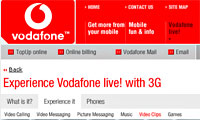 Sports fans will be kept amused on the move with Eurosport, UEFA Champions League and, err, Chilli TV (who?) channels, with the Vodafone service also carrying popular channels like MTV and Discovery.
Sports fans will be kept amused on the move with Eurosport, UEFA Champions League and, err, Chilli TV (who?) channels, with the Vodafone service also carrying popular channels like MTV and Discovery. Vodafone say that their research into the market revealed that Mobile TV complemented television viewing habits at home and thus demonstrated a hearty appetite for the product amongst consumers.
Vodafone say that their research into the market revealed that Mobile TV complemented television viewing habits at home and thus demonstrated a hearty appetite for the product amongst consumers. NTL is currently in talks to merge with Virgin Mobile in a deal that would create a potential rival to the now
NTL is currently in talks to merge with Virgin Mobile in a deal that would create a potential rival to the now  In a fiercely competitive market, cable companies on both sides of the Atlantic are looking to outflank their satellite and phone company rivals by adding mobile phone services to their portfolio of voice, Internet and TV services.
In a fiercely competitive market, cable companies on both sides of the Atlantic are looking to outflank their satellite and phone company rivals by adding mobile phone services to their portfolio of voice, Internet and TV services.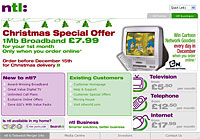 NTL and Telewest have notched up around 5 million subscribers combined, next to BSkyB’s 7.8 million digital television viewers.
NTL and Telewest have notched up around 5 million subscribers combined, next to BSkyB’s 7.8 million digital television viewers. Today will see the share IPO of Eutelsat, the third largest satellite operator.
Today will see the share IPO of Eutelsat, the third largest satellite operator.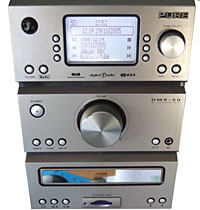 Despite our catastrophic experiences with the
Despite our catastrophic experiences with the 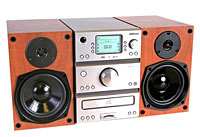 Context-sensitive buttons either side of the display provide a simple user interface offering fast access to relevant features – it’s one of the best interfaces we’ve seen.
Context-sensitive buttons either side of the display provide a simple user interface offering fast access to relevant features – it’s one of the best interfaces we’ve seen.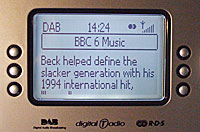 A unique feature to Pure is the ReVu function, which lets you pause and ‘rewind’ live DAB digital radio, courtesy of a constantly updating 20 minute buffer.
A unique feature to Pure is the ReVu function, which lets you pause and ‘rewind’ live DAB digital radio, courtesy of a constantly updating 20 minute buffer. The package is rounded off by two stylish Rosewood speakers with 5¼” woofers, and 19mm Mylar-dome tweeters, a simple remote control and aerial.
The package is rounded off by two stylish Rosewood speakers with 5¼” woofers, and 19mm Mylar-dome tweeters, a simple remote control and aerial. Yesterday evening saw a celebration of The Legacy of Arthur C Clarke at the IEE in London.
Yesterday evening saw a celebration of The Legacy of Arthur C Clarke at the IEE in London.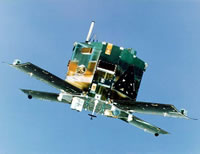 Professor Barry Evans of the University of Surrey considered the 1980’s and 90’s were probably the golden age for communication satellites and predicted their future as an infill technology. Working alongside terrestrial delivery systems, with the possibility of satellite providing TV connectivity to mobile devices outside the fibred home.
Professor Barry Evans of the University of Surrey considered the 1980’s and 90’s were probably the golden age for communication satellites and predicted their future as an infill technology. Working alongside terrestrial delivery systems, with the possibility of satellite providing TV connectivity to mobile devices outside the fibred home.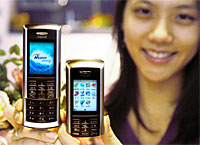 With a passion for creating new phones that is beginning to border on pathological, Samsung’s overworked designers have just revealed yet another new hi-tech handset, the SPH-V6800.
With a passion for creating new phones that is beginning to border on pathological, Samsung’s overworked designers have just revealed yet another new hi-tech handset, the SPH-V6800.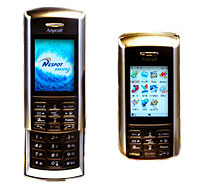 There’s also a 1.3MP digital camera onboard with MPEG-4 video recording and MP3/AAC audio playback.
There’s also a 1.3MP digital camera onboard with MPEG-4 video recording and MP3/AAC audio playback.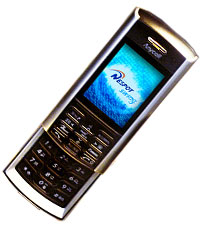 With the Samsung packing in wireless connectivity into its tiny 96.8 x 47 x 24.5mm dimensions, we could well be seduced by SPH-V6800 (if it ever makes it to these shores, of course).
With the Samsung packing in wireless connectivity into its tiny 96.8 x 47 x 24.5mm dimensions, we could well be seduced by SPH-V6800 (if it ever makes it to these shores, of course). In a sure sign that TV to the mobile is the new European media battleground, 3G mobile operator 3 Italia have announced its plans to purchase the Italian national broadcaster, Canale 7. Reports have put the price of the acquisition at between €30-35m.
In a sure sign that TV to the mobile is the new European media battleground, 3G mobile operator 3 Italia have announced its plans to purchase the Italian national broadcaster, Canale 7. Reports have put the price of the acquisition at between €30-35m.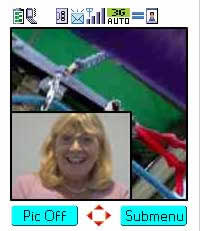 The company intends to offer a DVB-H mobile TV service from the second half of 2006. Indications are that there will be a minimum of 20 channels, although no line up has yet been decided. 3 Italia already carries Playboy adult entertainment and football via existing technology, and has worked with Mediaset and News Corp’s Sky Italia pay-TV operator.
The company intends to offer a DVB-H mobile TV service from the second half of 2006. Indications are that there will be a minimum of 20 channels, although no line up has yet been decided. 3 Italia already carries Playboy adult entertainment and football via existing technology, and has worked with Mediaset and News Corp’s Sky Italia pay-TV operator.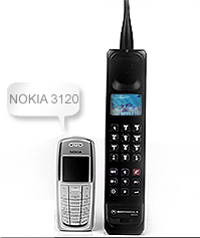 A Whole New Meaning To Retro
A Whole New Meaning To Retro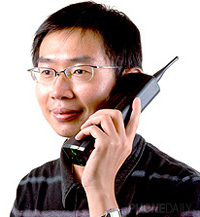 Ah ha! So that’s it: These “mobile phones” are actually weapons. Guess that means the end of taking my phone on the plane then! Still… The smiling Chinese man talking on his glorified, colour LCD display-equipped brick does look so innocent!
Ah ha! So that’s it: These “mobile phones” are actually weapons. Guess that means the end of taking my phone on the plane then! Still… The smiling Chinese man talking on his glorified, colour LCD display-equipped brick does look so innocent! For techie-obsessives like the Digital Lifestyles crew, keeping connected when we’re away from home is right up there with finding a roof over our heads, so when we went off to New York, we made sure we packed our Sony laptop and Wi-Fi enabled smartphone – even on holiday.
For techie-obsessives like the Digital Lifestyles crew, keeping connected when we’re away from home is right up there with finding a roof over our heads, so when we went off to New York, we made sure we packed our Sony laptop and Wi-Fi enabled smartphone – even on holiday. One rather unfortunate side-effect of all this free connectivity was that once-bustling cafes turned into conversation-free libraries, with rows of transfixed surfers staring intently into their screens, with the silence only broken by intermittent bursts of keyboard activity.
One rather unfortunate side-effect of all this free connectivity was that once-bustling cafes turned into conversation-free libraries, with rows of transfixed surfers staring intently into their screens, with the silence only broken by intermittent bursts of keyboard activity.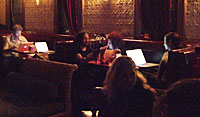 On the street, one handset seemed to be stuck in almost every New Yorker’s hand: the Palm Treo 750. They love the phone!
On the street, one handset seemed to be stuck in almost every New Yorker’s hand: the Palm Treo 750. They love the phone!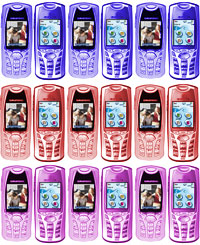 Market analyst Gartner reports that mobile phone sales have soared 22 percent compared to the same period last year.
Market analyst Gartner reports that mobile phone sales have soared 22 percent compared to the same period last year. In the Latin American segment, sales were up 46 per cent compared to last year, totalling 26.1 million phones units, while in Western Europe, big sales of 40 million phones were driven by customers upgrading their handsets.
In the Latin American segment, sales were up 46 per cent compared to last year, totalling 26.1 million phones units, while in Western Europe, big sales of 40 million phones were driven by customers upgrading their handsets.